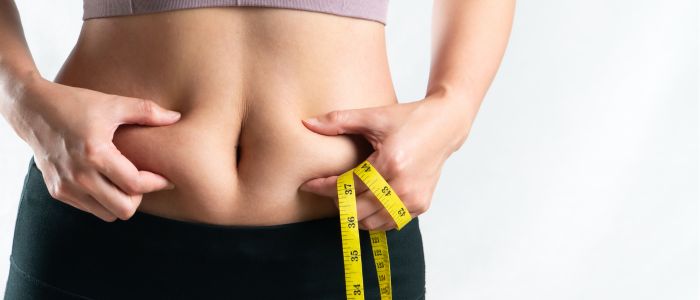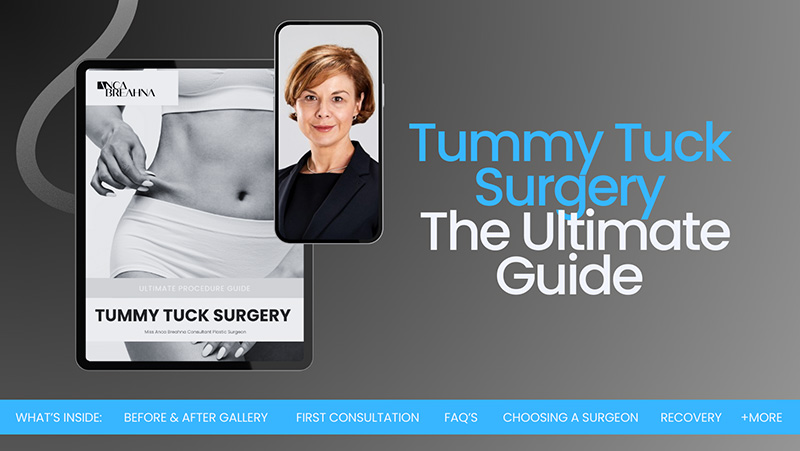
Beyond the Myths: The Realities of Tummy Tuck Surgery
Have you ever looked in the mirror and wished you could iron out the creases on your belly as easily as you do on your clothes? If so, you might have considered a tummy tuck surgery. This procedure can feel like a fresh start for many, especially after significant life changes such as weight loss or pregnancy. However, it’s surrounded by a cloud of myths that often obscure the truth. In this blog post, Consultant Plastic Surgeon Anca Breahna aims to smooth out the misconceptions and provide a clear, factual perspective on tummy tuck surgery.
Download the Tummy Tuck Guide

Myth #1: Tummy Tuck is a Quick Fix for Weight Loss
The idea that a tummy tuck is a quick and easy solution for weight loss is a widespread misconception. In reality, abdominoplasty is not a weight loss procedure but a body contouring surgery. It is designed to remove excess skin and small, localised fat deposits from the abdominal area, typically after significant weight loss, pregnancy, or when natural aging has caused the skin to lose its elasticity.
The procedure can certainly transform the appearance of the abdomen, making it appear flatter and more toned, but it does not significantly reduce body weight. Patients best suited for this surgery are those who are already close to their ideal body weight but struggle with stubborn areas of fat or loose skin that do not improve with diet and exercise. It’s important for potential patients to understand that a tummy tuck should be viewed as a complement to a healthy lifestyle, not a substitute for good nutrition and physical activity.
Fact: A tummy tuck improves body contour by tightening muscles and removing excess skin and fat, but it should not be considered a method for significant weight loss. It is most effective for refining and defining the midsection after one has achieved a stable weight through traditional weight loss methods.
Myth #2: Tummy Tucks Are Only for Women
While it’s true that the majority of tummy tuck patients are women, particularly those who have undergone multiple pregnancies, this doesn’t mean that men are excluded from benefiting from this procedure. Men also struggle with excess skin and fat around the abdomen, especially after undergoing substantial weight loss. For these men, a tummy tuck can be just as beneficial, helping to reduce the sagging skin and tighten the abdominal area for a more sculpted, masculine contour.
The procedure itself, the surgical techniques involved, and the recovery process are essentially the same for both genders. The goal is to create a smoother, firmer abdominal profile, which can significantly enhance anyone’s body image and confidence. Plastic surgeons tailor the procedure to each individual’s body type and aesthetic goals, ensuring that the results are appropriate and desirable, whether the patient is male or female.
Fact: Tummy tuck surgery is not gender-specific. It can be an excellent option for both men and women who meet the criteria of having excess abdominal skin and fat that does not respond to diet and exercise.
Myth #3: Tummy Tuck Recovery is Painful and Lengthy
Recovering from a tummy tuck does require time and patience, and it involves some level of discomfort. However, the notion that it is an exceedingly painful and protracted process is outdated. Advances in surgical techniques and pain management have significantly improved the postoperative experience. Most patients manage pain with prescribed medications and are encouraged to begin light walking and activities soon after surgery to facilitate healing.
The initial recovery period, during which patients may need help with daily activities, typically lasts about two weeks. Following this phase, gradual resumption of more strenuous activities is often possible over the next few weeks to months. Each patient’s recovery timeline can vary based on individual factors such as their health, the extent of surgery, and how closely they follow their plastic surgeon’s post-operative care instructions.
Fact: While tummy tuck recovery is not without discomfort and requires a downtime of a few weeks, modern pain management strategies and enhanced surgical techniques have made the recovery process much more manageable than in the past. Most patients find that the results are well worth the temporary inconvenience.
Myth #4: Tummy Tuck Procedures Are Risky
Like any surgical procedure, a tummy tuck carries inherent risks, but describing it as highly risky is an exaggeration. The risks associated with tummy tuck surgery are similar to those of other major surgeries but can be significantly minimised through the expertise of a qualified plastic surgeon and proper patient care before, during, and after the procedure.
Patients are carefully screened to ensure they are good candidates for the surgery, which includes evaluating their overall health, medical history, and specific risk factors. During the procedure, advanced techniques and rigorous safety protocols are employed to reduce the likelihood of complications such as infection, bleeding, or adverse reactions to anaesthesia. Moreover, following the surgery, complex post-operative instructions are provided to patients to aid in safe and effective recovery, and regular follow-up appointments are scheduled to monitor progress and address any concerns.
Fact: When performed by an experienced plastic surgeon, tummy tuck surgery has a low complication rate. Ensuring thorough pre-operative assessment and adhering strictly to post-operative care guidelines are key in mitigating risks.
Myth #5: Tummy Tuck Patients Will Have Limited Mobility after Surgery
It is true that tummy tuck surgery requires a period of reduced physical activity to allow the body to heal properly. However, the extent of mobility restrictions is often exaggerated. Patients are usually encouraged to start light walking as soon as it’s comfortable after surgery, typically within a day or two. This light activity helps improve circulation and reduces the risk of complications such as blood clots.
While heavy lifting and vigorous exercise are off-limits for several weeks, most patients begin to see improvements in their mobility within the first few weeks post-surgery. Adhering to the plastic surgeon’s guidelines helps ensure a smooth recovery and prevents complications. Over time, patients are able to return to all their usual activities without any permanent restrictions.
Fact: Initial post-surgery limitations are crucial for safe recovery, but these are temporary. Most tummy tuck patients regain full mobility and can return to active lifestyles once the recovery phase is complete.
Myth #6: Tummy Tuck Results Are Instant and Dramatic
Expecting instant results from a tummy tuck is a misunderstanding of the surgical process and healing timeline. Immediately following the surgery, swelling and bruising are common, which can obscure the new contours of the abdomen. It often takes several months for all swelling to subside and for the full effects of the procedure to be visible.
Patients should prepare for a gradual improvement rather than a dramatic overnight change. As the body heals, the results will start to unfold, revealing a flatter, more toned abdomen. It’s also important for patients to maintain a stable weight and healthy lifestyle to preserve the effects of the surgery.
Fact: The results of a tummy tuck are long-lasting and can be impressive, but they develop gradually and require patience as the body heals.
Myth #7: Tummy Tuck Surgery Is Only for Older Patients
Tummy tuck surgery is not restricted to any specific age group; it is suitable for anyone who meets the medical criteria and has realistic expectations about the outcomes. While it is popular among older individuals who experience natural loss of skin elasticity, younger patients also seek tummy tucks. These younger candidates often include women post-pregnancy or both men and women who have experienced significant weight loss that has left them with excess skin.
What’s important is not the age of the patient but their overall health, the quality of their skin, and their specific anatomical needs. A qualified surgeon evaluates these factors and more when determining whether a tummy tuck is suitable.
Fact: Tummy tuck surgery can benefit adults of various ages, targeting specific concerns related to excess skin and fat around the abdomen, provided they are in good health and have realistic expectations about the surgery and its results.
FAQs about Tummy Tuck Surgery
How do I know if I’m a good candidate for a tummy tuck?
- A good candidate for a tummy tuck is someone who is at or near their ideal weight, has realistic expectations about the results, and is in good general health. It’s particularly suited for those who have loose skin or excess fat that hasn’t responded to diet and exercise, often due to pregnancy or significant weight changes. A consultation with a plastic surgeon is necessary to assess your specific situation.
Can a tummy tuck be combined with other procedures?
- Yes, a tummy tuck can be combined with other procedures for superior body contouring results. Common combinations include liposuction, to further refine and shape the body contours, or breast procedures like augmentation or lift, often part of a “mummy makeover.” Combining surgeries can increase overall satisfaction but also requires careful consideration by your surgeon to ensure safety.
What are the differences between a full tummy tuck and a mini tummy tuck?
- A full tummy tuck involves an incision across the lower abdomen and around the belly button. It addresses loose skin, fat, and muscle tightening over the entire abdominal area. A mini tummy tuck uses a smaller incision and is focused on improving the lower belly below the belly button. It is less invasive and has a quicker recovery time but is suitable only for those with concerns confined to the lower abdomen.
How long do the results of a tummy tuck last?
- The results of a tummy tuck can be long-lasting if you maintain a stable weight and follow a healthy lifestyle. Changes in weight, including pregnancy, can alter the results. Ageing will naturally lead to some changes in body shape over time, but the improvements from a tummy tuck should be relatively permanent if significant weight fluctuations are avoided.
What should I expect during tummy tuck recovery in terms of support or garments?
- Post-operative care includes wearing a compression garment, which helps reduce swelling and supports the abdomen as it heals. This garment is typically worn for several weeks after the surgery. Your plastic surgeon will also provide detailed instructions on how to care for your surgical site, medications to apply or take orally to aid healing and reduce the risk of infection, and when to follow up for check-ups to monitor your recovery.
Further Reading about Tummy Tuck Surgery with Consultant Plastic Surgeon Anca Breahna
- Read more about Mini Tummy Tuck Vs Full Tummy Tuck
- Read more about Tummy Tuck after a C Section
- Read more about What Do Tummy Tuck Scars Look Like And Can They Be Reduced?
- Read more about What Is a Healthy Weight for Tummy Tuck Surgery?
- Read more about How Much Is a Tummy Tuck in the UK ?
- Read more about Best Candidates for the Mini Tummy Tuck
Medical References for Tummy Tuck
- ‘Tummy Tuck’ Improves Quality of Life in Overweight/Obese Patients
- Safe abdominoplasty with extensive liposuctioning
- Clinical outcome of patients undergoing abdominoplasty after massive weight loss
- Meta-analysis on the comparative efficacy of drains, progressive tension sutures and subscarpal fat preservation in reducing complications of abdominoplasty
- Abdominoplasty: classic principles and technique

 Ms Anca Breahna, PhD, MSc, FEBOPRAS, FRCS (Plast) is a highly regarded Consultant Plastic Surgeon specialising in the field of Aesthetic and Reconstructive Plastic Surgery. Anca performs a range of
Ms Anca Breahna, PhD, MSc, FEBOPRAS, FRCS (Plast) is a highly regarded Consultant Plastic Surgeon specialising in the field of Aesthetic and Reconstructive Plastic Surgery. Anca performs a range of 